Mechanical Harvesting Line Setting of Giant Reeds
Abstract
1. Introduction
2. Material and Methods
2.1. Environmental Aspects of the Experimental Site
2.2. Crop Management
2.3. Machine Characteristics and Performance
2.4. Quality of Work
2.5. Statistical Analysis
3. Results and Discussion
3.1. Harvesting—Step 1 (Shredding) and 2 (Baling)
3.2. Quality of Work
4. Conclusions
Author Contributions
Funding
Conflicts of Interest
References
- Vasconcelos, G.C.; Gomes, J.C.; Corrêa, L.A. Rendimento de biomassa da Cana-do-Reino (Arundo donax L.). Embrapa Clima Temperado Bol. Pesqui. Desenvolv. 2007, 42, 5–24. [Google Scholar]
- Pindozzi, S.; Faugno, S.; Cervelli, E.; Capolupo, A.; Sannino, M.; Boccia, L. Consequence of land use changes into energy crops in Campania region. J. Agric. Eng. 2013, 44, 467–471. [Google Scholar] [CrossRef]
- Ververis, C.; Georghiou, K.; Christodoulakis, N.; Santas, P.; Santas, R. Fiber dimensions, lignin and cellulose content of various plant materials and their suitability for paper production. Ind. Crops Prod. 2004, 19, 245–254. [Google Scholar] [CrossRef]
- Facchini, P. La Canna Gentile per la Produzione Della Cellulosa Nobile, L’impresa Agricolo-Industriale di Torviscova; Snia Viscosa: Milano, Italy, 1941. [Google Scholar]
- Williams, C.; Biswas, T. Commercial Potential of Giant Reed for Pulp, Paper and Biofuel Production; Rural Industries Research and Development Corporation: Kingston, Australia, 2010. [Google Scholar]
- Dragoni, F.; Ragaglini, G.; Corneli, E. Giant reed (Arundo donax L.) for biogas production: Land use saving and nitrogen utilisation efficiency compared with arable crops. Ital. J. Agron. 2015, 10, 192–201. [Google Scholar] [CrossRef]
- Pirozzi, D.; Fiorentino, N.; Impagliazzo, A.; Sannino, F.; Yousuf, A.; Fagnano, M. Lipid production from Arundo donax growth under different agronomical conditions. Renew. Energy 2015, 77, 456–462. [Google Scholar] [CrossRef]
- Pirozzi, D.; Yousuf, A.; Fagnano, M.; Mori, M.; Fiorentino, N.; Impagliazzo, A. Lipids production by yeast grown on giant reed biomass. J. Biotechnol. 2010, 150, 167–168. [Google Scholar] [CrossRef]
- Assirelli, A.; Civitarese, V.; Caracciolo, G.; Sannino, M.; Crimaldi, M.; Faugno, S. Double-pass harvesting system on giant reed in south Italy. In Proceedings of the 26th EUBCE European Biomass Conference and Exhibition, Copenhagen, Denmark, 14–18 May 2018; pp. 305–308. [Google Scholar]
- Hanegraaf, M.C.; Biowinga, E.E.; van der Bijl, G. Assessing the ecological and economic sustainability of energy crops. Biomass Bioenergy 1998, 15, 345–355. [Google Scholar] [CrossRef]
- Angelini, L.G.; Ceccarini, L.; Bonari, E. Biomass yield and energy balance of giant reed (Arundo donax L.) cropped in central Italy as related to different management practices. Eur. J. Agron. 2005, 22, 375–389. [Google Scholar] [CrossRef]
- Angelini, L.G.; Ceccarini, L.; Di Nasso, N.N.O.; Bonari, E. Comparison of Arundo donax L. and Miscantus x giganteus in a long-term field experiment in central Italy: Analysis of productive characteristics and energy balance. Biomass Bioenergy 2009, 33, 635–643. [Google Scholar] [CrossRef]
- Lewandowsky, I.; Scurlock, J.M.O.; Lindvall, E.; Christou, M. The development and current status of perennial rhizomatous grasses as energy crops in the US and Europe. Biomass Bioenergy 2003, 25, 335–361. [Google Scholar] [CrossRef]
- Faugno, S.; Civitarese, V.; Assirelli, A.; Sperandio, G.; Saulino, L.; Crimaldi, M.; Sannino, M. Chip quality as a function of harvesting methodology. Chem. Eng. Trans. 2017, 58, 271–276. [Google Scholar]
- Faugno, S.; Quacquarelli, I.; Civitarese, V.; Crimaldi, M.; Sannino, M.; Ricciardiello, G.; Caracciolo, G.; Assirelli, A. Two steps Arundo donax L. harvesting in south Italy. Chem. Eng. Trans. 2017, 58, 265–270. [Google Scholar]
- Ceotto, E.; Di Candilo, M. Shoot cuttings propagation of giant reed (Arundo donax L.) in water and moist soil: The path forward? Biomass Bioenergy 2010, 34, 1614–1623. [Google Scholar] [CrossRef]
- Assirelli, A.; Santangelo, E.; Spinelli, R.; Acampora, A.; Croce, S.; Civitarese, V.; Pari, L. Mechanization of Rizhome Extraction in Giant Reed (Arundo donax L.) Nurseries. Appl. Eng. Agric. 2013, 29, 489–494. [Google Scholar]
- Pari, L.; Suardi, A.; Giannini, E.; Civitarese, V. Strategie per meccanizzare la raccolta di canna comune. L’Informatore Agrar. 2009, 29, 22–25. [Google Scholar]
- Bentini, M.; Martelli, R. Prototype for the harvesting of cultivated herbaceous energy crops, an economic and technical evaluation. Biomass Bioenergy 2013, 57, 229–237. [Google Scholar] [CrossRef]
- Pari, L.; Curt, M.D.; Sanchez, J.; Santangelo, E. Economic and Energy analysis of different systems for giant reed (Arundo donax L.) harvesting in Italy and in Spain. Ind. Crops Prod. 2016, 84, 176–188. [Google Scholar] [CrossRef]
- Assirelli, A.; Croce, S.; Acampora, A.; Civitarese, V.; Suardi, A.; Santangelo, E.; Pari, L. An innovative System for conditioning Biomass Sorghum [Sorghum bicolor (L.) Moench.]. Trans. ASABE 2013, 56, 829–837. [Google Scholar]
- Acampora, A.; Assirelli, A.; Croce, S.; Gallucci, F.; Pari, L. Prove di raccolta di Arundo trinciato fresco e affienato. L’Informatore Agrar. 2014, 11, 20–23. [Google Scholar]
- Civitarese, V.; Assirelli, A.; Sperandio, G.; Caracciolo, G.; Faugno, S.; Sannino, M.; Crimaldi, M. Biomass quality of different species after storage. In Proceedings of the 26th EUBCE European Biomass Conference and Exhibition, Copenhagen, Denmark, 14–18 May 2018; pp. 342–345. [Google Scholar]
- Corno, L.; Lonati, S.; Cantaluppi, E.; Pilu, R.; Tosca, A.; Adani, F. Arundo ottima specie da biogas grazie alle altissime rese. L’Informatore Agrar. 2014, 5, 21–24. [Google Scholar]
- Di Nasso, N.N.O.; Angelini, L.G.; Bonari, E. Influence of fertilization and harvest time on fuel quality of giant reed (Arundo donax L.) in central Italy. Eur. J. Agron. 2010, 32, 219–227. [Google Scholar] [CrossRef]
- Christou, M.; Mardikis, M.; Alexopoulou, E. Alexopoulou, Giant reed (Arundo donax L.) network. Improvement, productivity and biomass quality. In Proceedings of the 1st World Conference Biomass for Energy and Industry, Sevilla, Spain, 5–9 June 2000; pp. 1803–1806. [Google Scholar]
- Yitao, L.; Qingxi, L.; Boping, T.; Caixia, S.; Jing, W.; Aili, M. Experimental research on the mechanical physical parameters of bottom stalk of the Arundo donax L. in harvesting period. Trans. Chin. Soc. Agric. Eng. 2007, 23, 124–129. [Google Scholar]
- Dahl, J.; Obernberger, I. Evaluation of the combustion characteristics of four perennial energy crops (Arundo donx, Cynara cardunculus, Miscanthus x giganteus and Panicum virgatum). In Proceedings of the Second World Biomass Conference, Biomass for Energy, Industry and Climate Protection, Rome, Italy, 10–14 May 2004; pp. 1265–1270. [Google Scholar]
- Cundiff, J.S. Simulation of five large round bale harvesting systems for biomass. Bioresour. Technol. 1996, 56, 77–82. [Google Scholar] [CrossRef]
- ISSS Working Group, RB. World Reference Base for Soil Resources: Introduction; Deckers, J.A., Nachtergaele, F.O., Spaargaren, O.C., Eds.; International Society of Soil Science (ISSS), International Soil Reference and Information Centre (ISRIC), and Food and Agriculture Organization (FAO), Acco: Leuven, Belgium, 1998; p. 165. [Google Scholar] [CrossRef]
- Fagnano, M.; Impagliazzo, A.; Mori, M.; Fiorentino, N. Agronomic and environmental impacts of giant reed (Arundo donax L.): Results from a long-term field experiment in hilly areas subject to soil erosion. Bioenergy Res. 2015, 8, 415–422. [Google Scholar] [CrossRef]
- ASAE. Agricultural Machinery Management; Standard ASAE EP 496.3; American Society of Agricultural and Biological Engineers: St. Joseph, MI, USA, 2007. [Google Scholar]
- ASAE. Agricultural Machinery Management; Standard ASAE EP 497.7; American Society of Agricultural and Biological Engineers: St. Joseph, MI, USA, 2011. [Google Scholar]
- Bodria, L.; Pellizzi, G.; Piccarolo, P. Meccanica Agraria; Il Sole 24 Ore Edagricole: Bologna, Italy, 2006; Volume 2. [Google Scholar]
- BSI. DD CEN/TS 14774-2:2004: Solid Biofuels: Methods for the Determination of Moisture Content; Oven Dry Method; Total Moisture; Simplified Method; British Standards Insitute: London, UK, 2004. [Google Scholar]
- Curt, M.D.; Sanz, M.; Mosquera, F.; Mauri, P.V.; Plaza, A.; Aguado, P.L.; Fernández, J. Harvest mechanization of Arundo donax L. in Spain. In Proceedings of the 21st EUBCE European Biomass Conference and Exhibition, Copenaghen, Denmark, 3–7 June 2013; pp. 302–307. [Google Scholar]
- Bentini, M.; Caliceti, M.; Zucchelli, M. Development of a prototype implement for Arundo donax L. harvesting for combustion purpose. In Proceedings of the 16th EUBCE European Biomass Conference & Exibition-From Research to Industry and Markets, Valencia, Spain, 2–6 June 2008; pp. 523–526. [Google Scholar]
- Demaldè, R.; Assirelli, A. Krone Big X 850, produttiva e potente. MAD - Macchine Agricole Domani. L’Informatore Agrario 2012, 9, 26–32. [Google Scholar]
- Assirelli, A.; Pignedoli, S. Costo di esercizio delle macchine agricole. Cent. Ric. Prod. Anim. 2005, 5, 1–10. [Google Scholar]
- Lyncaras, V.; Schneider, U.A. Multi-farm economic analysis of perennial energy crops in Central Greece, taking into account the CAP reform. Biomass Bioenergy 2011, 35, 700–715. [Google Scholar]
- Pignedoli, S.; Bettati, T.; Assirelli, A. Colture no food, un software aiuta a stimare costi e ricavi. Agricoltura 2008, 2, 104–105. [Google Scholar]
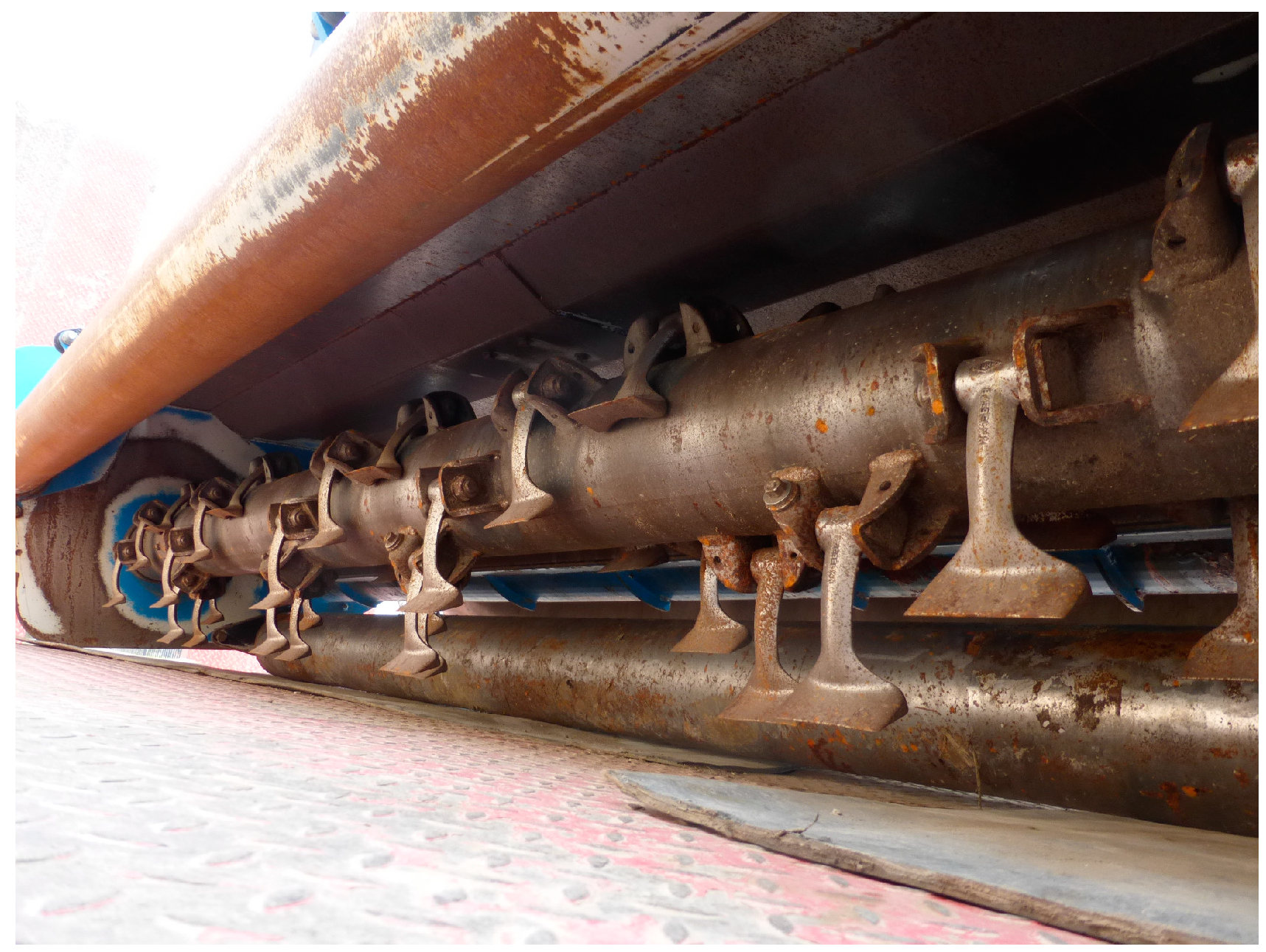
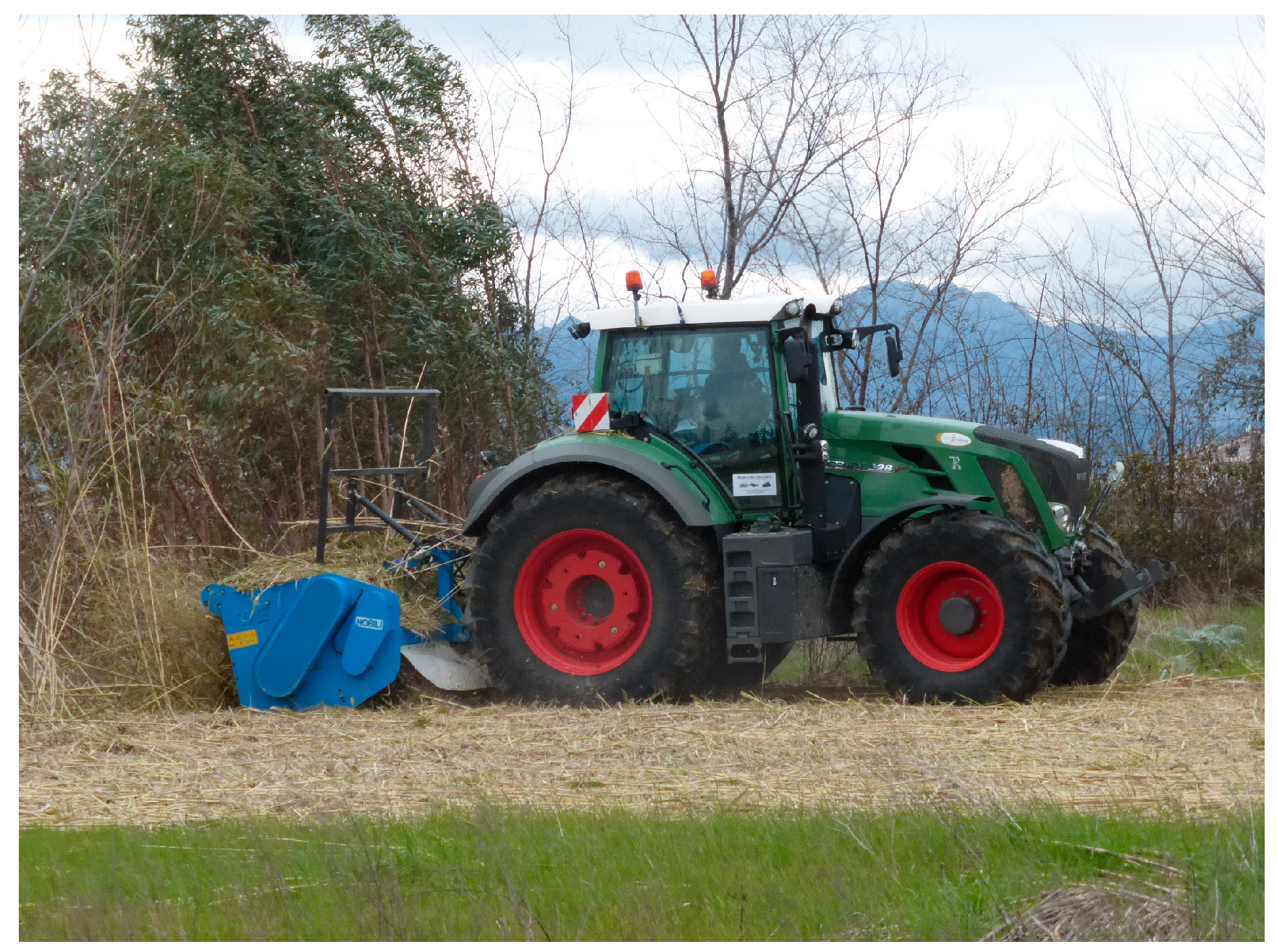
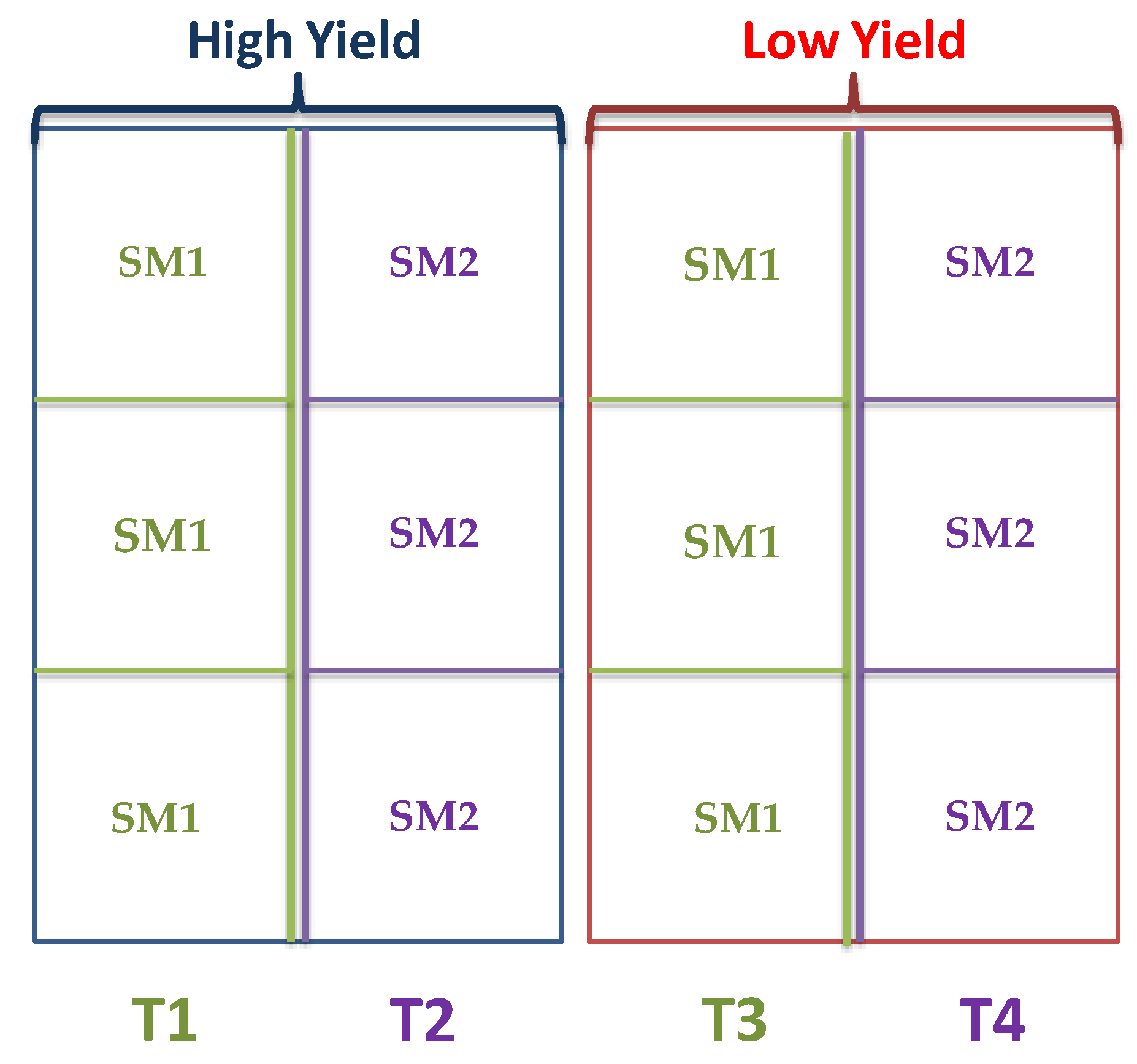
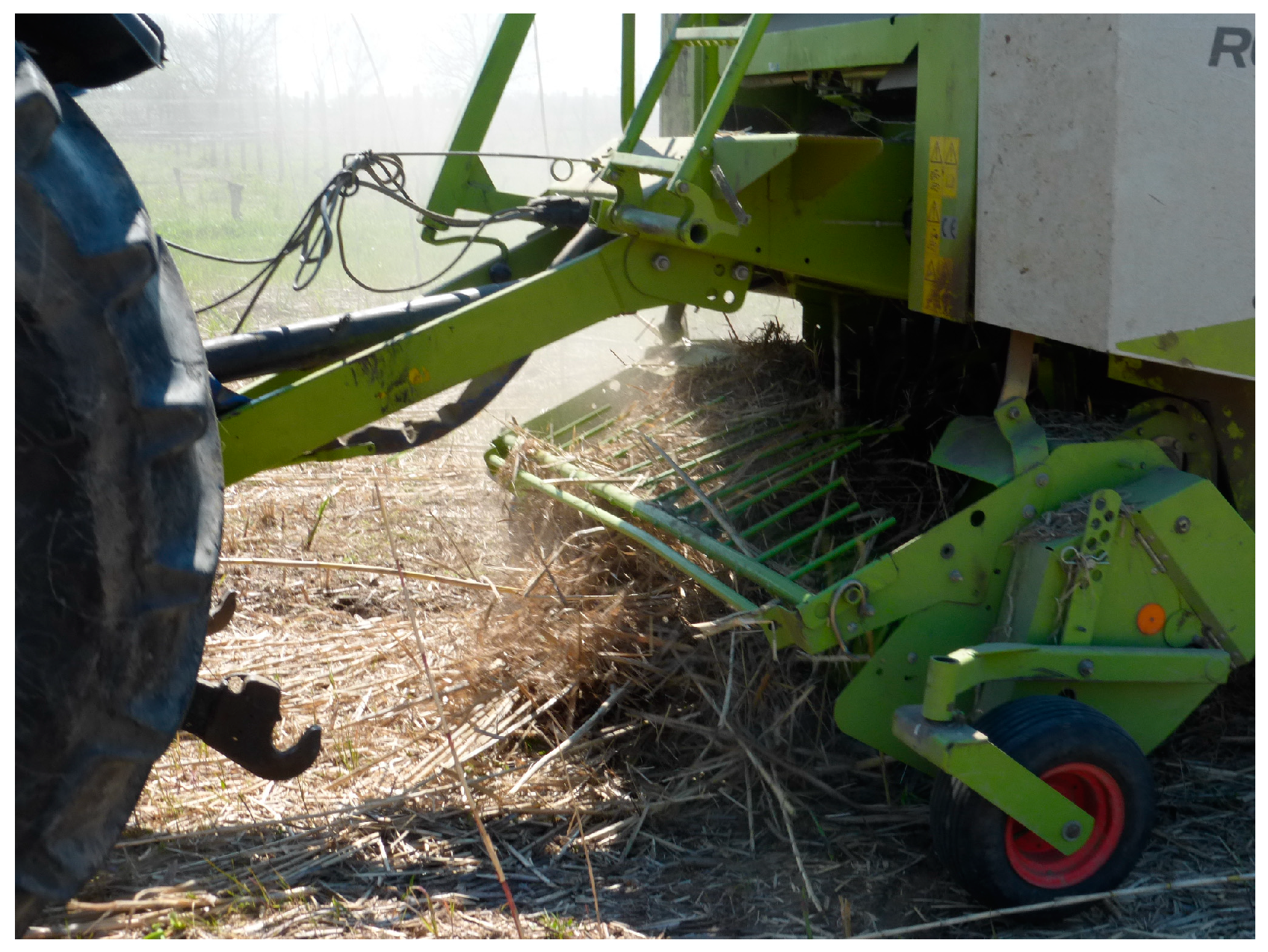
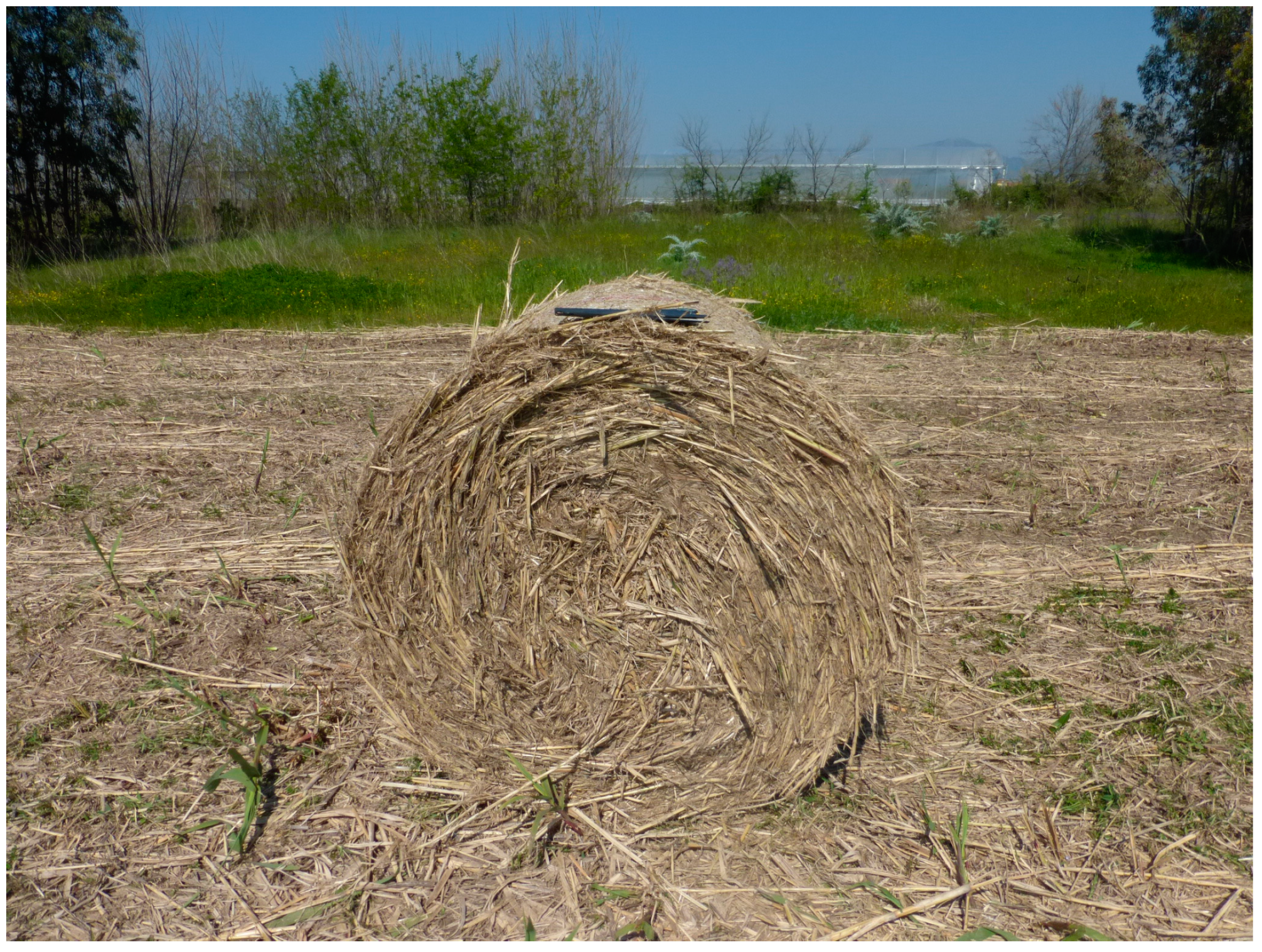
| Latitude | 40°36′50.49″ |
|---|---|
| Longitude | 14°55′19.46″ |
| Total area, m2 | 7450 |
| Transplant, year | 2007 |
| Inter-row spacing, m | 1 |
| Plants density, n ha−1 | 10,000 |
| Shredding date | 12/03/2015 |
| Baling date | 13/04/2015 |
| Parameter | T1 | T2 | T3 | T4 | ||||
|---|---|---|---|---|---|---|---|---|
| Values | % | Values | % | Values | % | Values | % | |
| Effective time (TE), s | 344 | 90.05 | 229 | 89.8 | 349 | 91.84 | 234 | 92.49 |
| Accessory time (TA), s | 38 | 9.95 | 26 | 10.2 | 31 | 8.16 | 19 | 7.51 |
| Turning time (TAV), s | 38 | 9.95 | 26 | 10.2 | 31 | 8.16 | 19 | 7.51 |
| Total, s | 382 | 100 | 255 | 100 | 380 | 100 | 253 | 100 |
| Effective Speed, km h−1 | 4.33 | 6.51 | 4.27 | 6.37 | ||||
| Operating Speed, km h−1 | 3.9 | 5.84 | 3.92 | 5.89 | ||||
| Effective field capacity(EFC), ha h−1 | 1.17 | 1.75 | 1.18 | 1.77 | ||||
| Material capacity, t h−1 | 35.15 | 52.66 | 32.68 | 49.09 | ||||
| Parameter | T1 | T2 | T3 | T4 | ||||
|---|---|---|---|---|---|---|---|---|
| Value | % | Value | % | Value | % | Value | % | |
| Effective time (TE), s | 127 | 58.26 | 302 | 78.85 | 288 | 75.2 | 140 | 68.63 |
| Accessory time (TA), s | 91 | 41.74 | 81 | 21.15 | 95 | 24.8 | 64 | 31.37 |
| Turning time (TAV), s | 25 | 11.47 | 21 | 5.48 | 23 | 6.01 | 22 | 10.78 |
| Maintenance time (TAS), s | 66 | 60 | 72 | 42 | ||||
| Total, s | 218 | 100 | 383 | 100 | 383 | 100 | 204 | 100 |
| Effective Speed, km h−1 | 5.81 | 4.89 | 5.13 | 6.55 | ||||
| Operating Speed, km h−1 | 3.39 | 3.85 | 3.85 | 4.5 | ||||
| Effective field capacity, ha h−1 | 0.71 | 0.81 | 0.81 | 0.95 | ||||
| Material capacity, t h−1 | 18.5 | 21.05 | 19.46 | 22.76 | ||||
| Machine Setting | Yield | Hourly Consumption, l h−1 | Area Consumption, l ha−1 | Material Consumption, l t−1 | |||||||||
|---|---|---|---|---|---|---|---|---|---|---|---|---|---|
| Step 1 | Step 2 | Step 1 | Step 2 | Step 1 | Step 2 | ||||||||
| SM1 | high | 18 | n.s | 17.5 | b | 15.3 | b | 24.7 | b | 0.51 | b | 0.95 | b |
| SM2 | high | 20 | 19 | b | 11.4 | a | 23.4 | b | 0.38 | a | 0.9 | b | |
| SM1 | low | 21 | 13 | a | 17.9 | b | 16 | a | 0.64 | b | 0.67 | a | |
| SM2 | low | 22 | 12 | a | 12.3 | a | 12.6 | a | 0.45 | a | 0.53 | a | |
| Machine Setting | Yield | Stem Height, cm | Dry Matter Losses t ha−1 | ||||
|---|---|---|---|---|---|---|---|
| Step 1 | Step 2 | ||||||
| SM1 | high | 10.5 | b | 2.65 | n.s. | 3.38 | n.s. |
| SM2 | high | 11.6 | b | 1.46 | 3.10 | ||
| SM1 | low | 13.3 | a | 1.35 | 3.01 | ||
| SM2 | low | 14.4 | a | 1.35 | 3.01 | ||
| Cutting Height, cm | Ground Loss, t ha−1 | |
|---|---|---|
| High speed | 12.50 | 1.11 |
| Low speed | 11.90 | 1.06 |
| High Yield | Low Yield | |
|---|---|---|
| Shredding | 2.17 | 1.46 |
| Baling | 2.3 | 2.13 |
| Total | 4.47 | 3.59 |
© 2019 by the authors. Licensee MDPI, Basel, Switzerland. This article is an open access article distributed under the terms and conditions of the Creative Commons Attribution (CC BY) license (http://creativecommons.org/licenses/by/4.0/).
Share and Cite
Assirelli, A.; Civitarese, V.; Caracciolo, G.; Sannino, M.; Faugno, S. Mechanical Harvesting Line Setting of Giant Reeds. Appl. Sci. 2019, 9, 5425. https://doi.org/10.3390/app9245425
Assirelli A, Civitarese V, Caracciolo G, Sannino M, Faugno S. Mechanical Harvesting Line Setting of Giant Reeds. Applied Sciences. 2019; 9(24):5425. https://doi.org/10.3390/app9245425
Chicago/Turabian StyleAssirelli, Alberto, Vincenzo Civitarese, Giuseppina Caracciolo, Maura Sannino, and Salvatore Faugno. 2019. "Mechanical Harvesting Line Setting of Giant Reeds" Applied Sciences 9, no. 24: 5425. https://doi.org/10.3390/app9245425
APA StyleAssirelli, A., Civitarese, V., Caracciolo, G., Sannino, M., & Faugno, S. (2019). Mechanical Harvesting Line Setting of Giant Reeds. Applied Sciences, 9(24), 5425. https://doi.org/10.3390/app9245425






